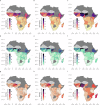Subnational variations in the quality of household survey data in sub-Saharan Africa
- PMID: 40263256
- PMCID: PMC12015360
- DOI: 10.1038/s41467-025-58776-5
Subnational variations in the quality of household survey data in sub-Saharan Africa
Abstract
Nationally representative household surveys collect geocoded data that are vital to tackling health and other development challenges in sub-Saharan Africa. Scholars and practitioners generally assume uniform data quality but subnational variation of errors in household data has never been investigated at high spatial resolution. Here, we explore within-country variation in the quality of most recent household surveys for 35 African countries at 5 × 5 km resolution and district levels. Findings show a striking heterogeneity in the subnational distribution of sampling and measurement errors. Data quality degrades with greater distance from settlements, and missing data as well as imprecision of estimates add to quality problems that can result in vulnerable remote populations receiving less than optimal services and needed resources. Our easy-to-access geospatial estimates of survey data quality highlight the need to invest in better targeting of household surveys in remote areas.
© 2025. The Author(s).
Conflict of interest statement
Competing interests: The authors declare no competing interests.
Figures



Similar articles
-
Determinants of solid fuel use in Sub-Saharan Africa: A multilevel analysis using DHS data.PLoS One. 2025 Apr 25;20(4):e0321721. doi: 10.1371/journal.pone.0321721. eCollection 2025. PLoS One. 2025. PMID: 40279350 Free PMC article.
-
Subnational estimation of modern contraceptive prevalence in five sub-Saharan African countries: a Bayesian hierarchical approach.BMC Public Health. 2019 Feb 20;19(1):216. doi: 10.1186/s12889-019-6545-3. BMC Public Health. 2019. PMID: 30786895 Free PMC article.
-
Limited handwashing facility and associated factors in sub-Saharan Africa: pooled prevalence and multilevel analysis of 29 sub-Saharan Africa countries from demographic health survey data.BMC Public Health. 2022 Oct 27;22(1):1969. doi: 10.1186/s12889-022-14390-4. BMC Public Health. 2022. PMID: 36303201 Free PMC article.
-
Coverage of intermittent preventive treatment and insecticide-treated nets for the control of malaria during pregnancy in sub-Saharan Africa: a synthesis and meta-analysis of national survey data, 2009-11.Lancet Infect Dis. 2013 Dec;13(12):1029-42. doi: 10.1016/S1473-3099(13)70199-3. Epub 2013 Sep 18. Lancet Infect Dis. 2013. PMID: 24054085 Review.
-
Inequality of child mortality among ethnic groups in sub-Saharan Africa.Bull World Health Organ. 2000;78(1):30-41. Bull World Health Organ. 2000. PMID: 10686731 Free PMC article. Review.
Cited by
-
Trend analysis and epidemiological forecasting of colorectal Cancer mortality among reproductive-age women in sub-Saharan Africa.Prev Med Rep. 2025 Jul 7;56:103167. doi: 10.1016/j.pmedr.2025.103167. eCollection 2025 Aug. Prev Med Rep. 2025. PMID: 40687057 Free PMC article.
References
-
- Devarajan, S. Africa’s Statistical Tragedy. Rev. Income Wealth59, S9–S15 (2013).
-
- Jerven, M. Poor Numbers: How We Are Misled by African Development Statistics and What to Do about It. (Cornell University Press, 2013).
-
- Pelletier, F. Census counts, undercounts and population estimates: The importance of data quality evaluation. Population Division, United Nations Department of Economic and Social Affairs. Technical Paper No2, (2020).
-
- Randall, S. & Coast, E. The quality of demographic data on older Africans. Demographic Res.34, 143–174 (2016).
MeSH terms
Grants and funding
LinkOut - more resources
Full Text Sources

